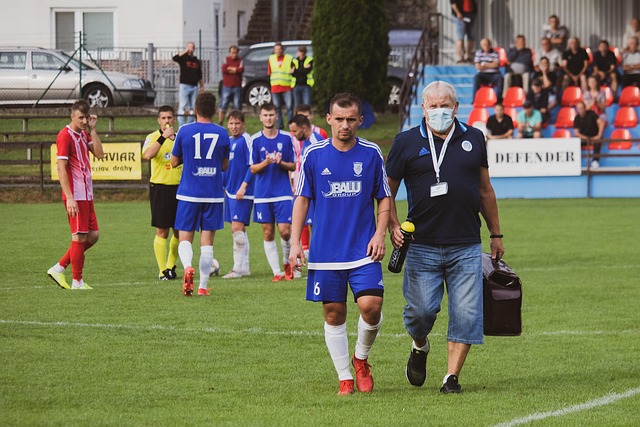Platelet-rich plasma (PRP) therapy emerges as a cutting-edge solution for sports injury recovery, offering faster healing times and minimal side effects compared to cortisone injections. Derived from an athlete's blood, PRP contains growth factors that stimulate tissue repair and reduce inflammation. This natural approach enhances long-term recovery, enabling athletes to return to competition safely and effectively while mitigating future injury risks through optimal tissue health.
In the quest for effective sports injury recovery, athletes often turn to two popular treatments: Platelet-Rich Plasma (PRP) and cortisone injections. This article delves into these methods, dissecting their underlying science, benefits, and risks. We explore how PRP, a natural healing tool, compares to traditional cortisone shots, focusing on its efficacy in athletic recovery. Furthermore, we examine the long-term advantages of PRP as a sustainable solution for sports injuries.
Understanding PRP: The Basic Science Behind It
Platelet-rich plasma (PRP) is a cutting-edge therapy gaining popularity in sports medicine for its potential to accelerate athletes’ recovery from injuries. The basic science behind PRP involves harnessing the body’s natural healing mechanisms. It starts with drawing a small amount of an athlete’s blood and spinning it in a centrifuge machine, which separates out the platelets from other components. Platelets are known to contain growth factors that play a crucial role in tissue repair and regeneration. By concentrating these platelets in a plasma solution, PRP creates a powerful healing agent. This concentrated mixture is then injected into the affected area, such as a sprained ankle or tendinopathy, to stimulate natural healing processes, promote tissue repair, and reduce inflammation.
PRP therapy offers a more natural approach compared to cortisone injections, which can provide rapid relief but may have potential side effects, including suppressing the body’s inherent inflammatory response. With its ability to enhance the body’s own healing capabilities, PRP has become an attractive option for athletes seeking effective yet minimally invasive treatments for sports injuries, aiming to get back in the game faster and potentially avoid more aggressive intervention.
Cortisone Injections: How They Work and Their Risks
Cortisone injections have long been a go-to treatment for athletes dealing with acute or chronic pain associated with sports injuries. These powerful anti-inflammatory medications work by reducing swelling and irritation in the affected area, providing instant relief and improved mobility. However, while they offer quick results, there are risks associated with repeated use.
Over time, cortisone injections can weaken surrounding tissues, leading to muscle atrophy and tendon damage. It may also suppress the body’s natural healing process, making it less effective in regenerating injured tissue. This is especially concerning for athletes as it can hinder their long-term recovery and increase the risk of future injuries. In contrast, platelet-rich plasma (PRP) therapy offers a more natural approach to sports injury recovery with PRP, harnessing the body’s own healing mechanisms without the potential side effects of cortisone injections.
Comparing Efficacy: PRP vs. Cortisone for Athletes
In the realm of sports medicine, both Platelet-Rich Plasma (PRP) and cortisone injections have garnered attention for their potential in treating athletic injuries. When it comes to efficacy, PRP has gained popularity as a game-changer in sports injury recovery with its natural ability to stimulate tissue repair. PRP is derived from the athlete’s own blood, rich in growth factors that promote healing. Studies suggest that PRP can significantly reduce pain and inflammation, allowing athletes to return to their activities faster than traditional cortisone injections.
Cortisone, while effective in reducing inflammation, carries potential side effects and may not provide the same level of long-term benefits as PRP. Unlike cortisone, which acts as a quick fix, PRP offers a more holistic approach by accelerating the body’s natural healing process. This makes PRP an appealing choice for athletes seeking a safe and effective solution for persistent injuries, ensuring they can return to their sport with enhanced performance and reduced risk of future complications.
Long-Term Recovery: Sustainable Solutions with PRP
PRP (Platelet-Rich Plasma) therapy offers a promising long-term solution for athletes dealing with sports injuries, promoting faster and more sustainable recovery compared to cortisone injections. This natural approach leverages the body’s own healing mechanisms by utilizing concentrated platelets rich in growth factors, which accelerate tissue repair and regeneration. Unlike cortisone, known for its anti-inflammatory effects but potential side effects, PRP provides a more holistic method to combat inflammation while stimulating the body’s inherent healing process.
By embracing PRP as part of their recovery regimen, athletes can enjoy faster return to play times without the risks associated with long-term cortisone use. The non-invasive nature and minimal downtime make PRP an attractive option for maintaining athletic performance while ensuring optimal tissue health in the long run, making it a game-changer in sports injury recovery with PRP.
In the quest for optimal sports injury recovery, both Platelet-Rich Plasma (PRP) and cortisone injections have been subject to comparison. PRP offers a promising approach by harnessing the body’s natural healing mechanism, demonstrating enhanced efficacy and long-term benefits for athletes. While cortisone injections provide quick relief, they are associated with potential risks and may not offer sustainable recovery solutions. Considering the evolving landscape of sports medicine, PRP emerges as a game-changer for effective and safe sports injury management, particularly in promoting long-term healing for athletes.
